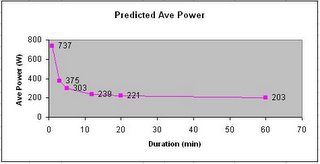Indoor Time Trial Series
I just started an Indoor Time Trial Series topic on the Gulf Coast Cycle Fit forum. Let me know what you think of this type of competition. Go to www. gccyclefit.com and click the link to GCCYCLEFIT FORUM.
I just started an Indoor Time Trial Series topic on the Gulf Coast Cycle Fit forum. Let me know what you think of this type of competition. Go to www. gccyclefit.com and click the link to GCCYCLEFIT FORUM.
Now that Thanksgiving is over, I have more reasons ( in lbs.) to workout.
Take a look at the rider in front of you. Go on...look. What do you see?
This is the reason to be in the service business. There's no greater feeling than being able to help someone move toward success. It's a rush to see someone when they realize that they have a new tool that will help them achieve their goals. That is what the Spinscan has been for clients.
As I understand it, the critical power for a given time interval is the absolute greatest average power that can be sustained for that period. That would be the academic definition. I don't know if it's that easy to determine in real life. I guess I would figure that I could always give just that little bit more. But, who knows.
This is the coolest training tool I've seen. It's a critical power predictor.

I'm kicking around a few ideas about cycling priorities when it comes to being fast
I guess you can't ask for anything better. A beautiful October day in the 70's. It was kind of cool this morning when we started riding but it warmed up rather quickly.
I guess you can't ask for anything better. A beautiful October day in the 70's. It was kind of cool this morning when we started riding but it warmed up rather quickly.
Too Cool! Maybe this is the reason that cycling has such appeal. There is always some aspect of cycling where we can improve and become more proficient. Next year, I'll be 40. I don't have many years to focus on brute strength. Maybe I'm over the hump already and I'm in denial. Who knows.
Great ride yesterday morning. So much time has been spent on technique recently that I haven't been riding with any speed. I decided to take it up a notch this morning. Don't get scared, I'm only talking a "small" notch.
I've been looking over some of the recent posts. I apologize for all the fragmented information. I'm sure it will get better with time.
Made a few changes to the website tonight. Gulf Coast Cycle Fit . Added a cycling priorities list to the TRAINING page. If you have any additions to the list, let me know. Also, look for ride and race calendar information in the near future. If you have ride calendar additions, let me know by emailing me.
Yes, I'm taking the same medicine that I've written about recently. Cycling skill and technique. It's like starting all over for me. I had a rude awakening when I originally set up the Computrainer. I was faced with the fact that my pedalling technique SUCKED!.